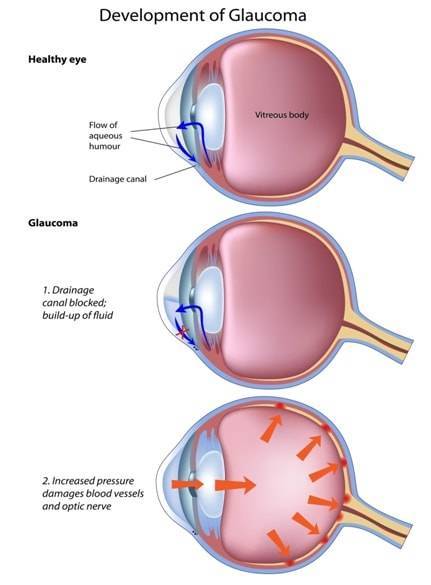
Contents
- What is glaucoma?
- What causes glaucoma?
- Who is prone to glaucoma?
- What are the symptoms of glaucoma? How is glaucoma diagnosed?
- What are the complications of glaucoma?
- What is the treatment of glaucoma?
You can click on any of the links above to navigate to the section of your interest.
Related Topics
Corrective Eye Surgery Procedures: Cost & Eligibility
LASIK (Laser-Assisted in Situ Keratomileusis)
Epi LASIK (Epipolis Laser In Situ Keratomileusis)
LASEK (Laser Epithelial Keratomileusis)
PRK (Photorefractive Keratectomy)
What is glaucoma?
The term glaucoma describes a group of eye diseases, characterized by progressive and irreversible damage to the optic nerve, which is responsible for vision in the eye. Glaucoma can lead to blindness if left untreated. The condition develops when the eye pressure rises, i.e. the pressure maintained by the fluid in the eye, though sometimes some individuals can develop glaucoma even with normal eye pressure.
Normal eye pressure ranges from 12-22 mm Hg, and eye pressure greater than 22 mm Hg is considered higher than normal.
What causes glaucoma?
Glaucoma results from high fluid pressure inside your eye. It occurs when the liquid in the front part of the eye, also called aqueous humor, doesn't circulate the way it should.
Aqueous humor, normally flows out of your eye through a mesh-like channel. If this channel gets blocked, the liquid unable to flow naturally, builds up. That’s when glaucoma occurs. Though the cause of the blockage remains unknown, experts feel it could be hereditary, i.e. passed on from parents to child.
Apart from heredity, other factors that could cause glaucoma are:
- A blunt or chemical injury to the eye
- Blockage of blood vessels in the eye
- Eye infection
- Inflammation in the eyes
- Eye surgery (very rarely)
Based on the factors causing it glaucoma can be of four types:
- Primary open-angle glaucoma
- Primary angle-closure glaucoma
- Developmental glaucoma (which affects children)
- Secondary glaucoma (which occurs due to other disorders of the eye or the body)
Who is prone to glaucoma?
People who are prone to glaucoma include:
- people 60 years of age or older
- people belonging to certain ethnic groups, including black and Latino
- a family history of glaucoma
- people suffering from high pressure in the eyes
- diabetes patients
- people with high blood pressure/hypertension
- people with heart disease
- nearsightedness (it is difficult for you to see objects in the distance)
What are the symptoms of glaucoma? How is glaucoma diagnosed?
The symptoms of glaucoma include:
- hazy or blurred vision
- the appearance of rainbow-colored circles around bright lights
- severe eye and head pain
- nausea or vomiting accompanied by severe eye pain
- sudden sight loss
Diagnosis
The only way to diagnose glaucoma is to get a complete eye check up done. During a glaucoma eye exam the ophthalmologist will:
- examine your optic nerve for any damage
- take a picture or computer measurement of your optic nerve
- measure the thickness of your cornea
- measure your eye pressure
- inspect your eye’s drainage angle
- test your peripheral (side) vision
What are the complications of glaucoma?
The complications of glaucoma include:
- damaged nerve cells
- blind spots on the peripheral vision which can cause motor accidents
- vision loss
- affected central vision if glaucoma is not treated
What is the treatment of glaucoma?
The treatment of glaucoma centres around managing the intraocular pressure (IOP) to minimize damage to the optic nerve. Based on your condition the doctor may prescribe glaucoma eye drops which can be very effective at controlling IOP to prevent eye damage.
For some people, however, glaucoma eye drops are not suitable. In those cases, the doctor may suggest a surgery. Oral medications can also be prescribed by the doctor.
Surgeries for glaucoma include:
- Laser therapy
- Filtering surgery
- Drainage tubes
- Electrocautery
Patient Experiences



Questions answered by trusted doctors


Did you know?
Leading cause of blindness
Glaucoma is the second leading cause of blindness in the world accounting for upto 8% of total blindness.
Glaucoma in India
In India , glaucoma is the leading cause of irreversible blindness with at least 12 million people affected and nearly 1.2 million people blind from the disease.
Related videos
Related articles
The treatment method of using various treatments like chemotherapy, radiation, anti-cancer drugs to either cure, treat, control, or reduce the symptoms of any types of cancer can be grouped together as cancer treatments.
Cataracts occur as a part of the body's natural ageing process. A cataract is clouding of the eye's natural lens, which lies behind the iris and pupil. Know more about Cataracts, its causes, symptoms, treatment and videos on Health-Wiki | Practo
LASIK [Laser-Assisted in Situ Keratomileusis] is a type of refractive surgery in which a laser is used to enhance or improve the vision of the eye. It helps in treating near and far sightedness, and Astigmatism.


A. Best test to ask for screening glaucoma is perimetry test
B. You can't self diagnose glaucoma
C. Doctor will examine the optic nerve head,record intraocular pressure and may advise for visual field test( perimetry) which is best test to evaluate glaucoma